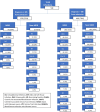Antibiotic susceptibility patterns at the Médecins Sans Frontières (MSF) Acute Trauma Hospital in Aden, Yemen: a retrospective study from January 2018 to June 2021
- PMID: 38449518
- PMCID: PMC10914454
- DOI: 10.1093/jacamr/dlae024
Antibiotic susceptibility patterns at the Médecins Sans Frontières (MSF) Acute Trauma Hospital in Aden, Yemen: a retrospective study from January 2018 to June 2021
Abstract
Background: Antimicrobial resistance (AMR) is an urgent global health concern, especially in countries facing instability or conflicts, with compromised healthcare systems. Médecins Sans Frontières (MSF) established an acute trauma hospital in Aden, Yemen, treating mainly war-wounded civilians, and implemented an antimicrobial stewardship (AMS) programme. This study aimed to describe clinical characteristics and identify antibiotic susceptibility patterns representative of patients treated with antibiotics.
Methods: Retrospective cross-sectional study using routinely collected data from all patients treated with antibiotics in the MSF-Aden Acute Trauma hospital between January 2018 and June 2021. Routine clinical data from patients' files was entered into an AMS electronic database and microbiological data were entered into WHONET. Both databases were imported and merged in REDCap and analysed using RStudio.
Results: Three hundred and sixty-three of 481 (75%) included patients were injured by violence-related trauma. Most were men aged 19-45 years (n = 331; 68.8%). In total, 598 infections were diagnosed and treated. MDR organisms were identified in 362 (60.5%) infections in 311 (65%) patients. Skin and soft-tissue infections (SSTIs) (n = 143; 24%) were the most common, followed by osteomyelitis (n = 125; 21%) and intra-abdominal-infections (IAIs) (n = 116; 19%), and 111 (19%) secondary bloodstream infections were identified. Escherichia coli was the most frequently identified pathogen, causing IAI (n = 87; 28%) and SSTI (n = 43; 16%), while Staphylococcus aureus caused mainly osteomyelitis (n = 84; 19%). Most Gram-negatives were ESBL producers, including E. coli (n = 193; 81.4%), Klebsiella pneumoniae (n = 72; 77.4%) and Enterobacter cloacae (n = 39; 50%) while most S. aureus were methicillin resistant (n = 93; 72.6%).
Conclusions: High rates of MDR were found. This information will facilitate a comprehensive review of the empirical antibiotic treatment guidelines.
© The Author(s) 2024. Published by Oxford University Press on behalf of British Society for Antimicrobial Chemotherapy.
Figures




Similar articles
-
Post-traumatic osteomyelitis in Middle East war-wounded civilians: resistance to first-line antibiotics in selected bacteria over the decade 2006-2016.BMC Infect Dis. 2019 Jan 31;19(1):103. doi: 10.1186/s12879-019-3741-9. BMC Infect Dis. 2019. PMID: 30704410 Free PMC article.
-
Sulopenem: An Intravenous and Oral Penem for the Treatment of Urinary Tract Infections Due to Multidrug-Resistant Bacteria.Drugs. 2022 Apr;82(5):533-557. doi: 10.1007/s40265-022-01688-1. Epub 2022 Mar 16. Drugs. 2022. PMID: 35294769 Review.
-
Multidrug-Resistant and Virulent Organisms Trauma Infections: Trauma Infectious Disease Outcomes Study Initiative.Mil Med. 2022 May 4;187(Suppl 2):42-51. doi: 10.1093/milmed/usab131. Mil Med. 2022. PMID: 35512375 Free PMC article. Review.
-
The challenge of antibiotic resistance in post-war Mosul, Iraq: an analysis of 20 months of microbiological samples from a tertiary orthopaedic care centre.J Glob Antimicrob Resist. 2022 Sep;30:311-318. doi: 10.1016/j.jgar.2022.06.022. Epub 2022 Jun 26. J Glob Antimicrob Resist. 2022. PMID: 35768065
-
Literature review on the distribution characteristics and antimicrobial resistance of bacterial pathogens in neonatal sepsis.J Matern Fetal Neonatal Med. 2022 Mar;35(5):861-870. doi: 10.1080/14767058.2020.1732342. Epub 2020 Feb 26. J Matern Fetal Neonatal Med. 2022. PMID: 32102584 Review.
Cited by
-
Posttraumatic Pseudomonas aeruginosa Osteomyelitis in Mosul and Gaza: A Retrospective Cohort Study, 2018-2022.Open Forum Infect Dis. 2024 Oct 7;11(10):ofae579. doi: 10.1093/ofid/ofae579. eCollection 2024 Oct. Open Forum Infect Dis. 2024. PMID: 39411226 Free PMC article.
-
Fighting Antibiotic Resistance: Insights Into Human Barriers and New Opportunities: Antibiotic Resistance Constantly Rises With the Development of Human Activities. We discuss Barriers and Opportunities to Get It Under Control.Bioessays. 2025 Jun;47(6):e70001. doi: 10.1002/bies.70001. Epub 2025 Mar 27. Bioessays. 2025. PMID: 40143711 Free PMC article. Review.
-
Conflict-associated wounds and burns infected with GLASS pathogens in the Eastern Mediterranean Region: A systematic review.BMC Infect Dis. 2025 Feb 7;25(1):187. doi: 10.1186/s12879-025-10569-3. BMC Infect Dis. 2025. PMID: 39920648 Free PMC article.
-
Antimicrobial resistance surveillance and trends in armed conflict, fragile, and non-conflict countries of the Eastern Mediterranean Region.Infect Dis Poverty. 2025 Feb 28;14(1):14. doi: 10.1186/s40249-025-01287-8. Infect Dis Poverty. 2025. PMID: 40022264 Free PMC article.
-
Necrotizing Fasciitis: A Retrospective Review of the Microbiological Aspects and Factors Associated with Multi-Drug Resistance from a Saudi Tertiary Care Hospital.Int J Gen Med. 2025 Jul 19;18:3983-4000. doi: 10.2147/IJGM.S533021. eCollection 2025. Int J Gen Med. 2025. PMID: 40703328 Free PMC article.
References
-
- Interagency Coordination Group on Antimicrobial Resistance . No time to wait: securing the future from drug-resistant infections. Report to the Secretary-General of the United Nations. 2019. https://www.who.int/docs/default-source/documents/no-time-to-wait-securi....
-
- O’Neill J. Tackling drug-resistant infections globally: final report and recommendations the review on antimicrobial resistance. 2016. https://amr-review.org/sites/default/files/160518_Final%20paper_with%20c....
LinkOut - more resources
Full Text Sources
Miscellaneous
